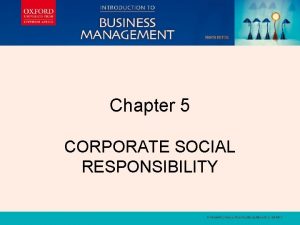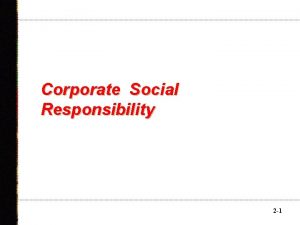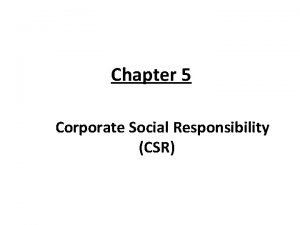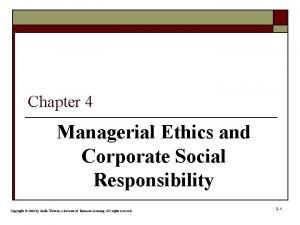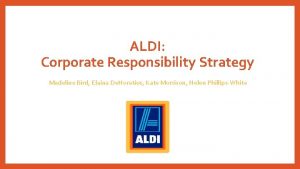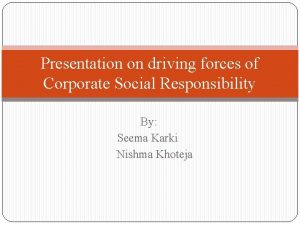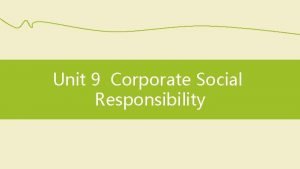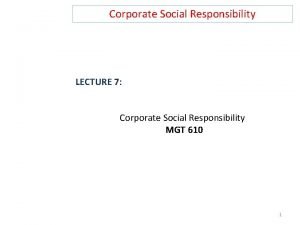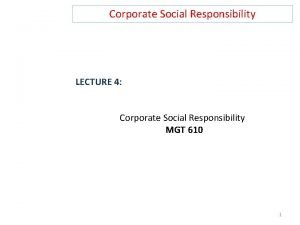INSTRUCTORS MANUAL Chapter 5 INSTRUCTORS MANUAL CORPORATE SOCIAL















- Slides: 15

INSTRUCTOR'S MANUAL Chapter 5 INSTRUCTOR'S MANUAL CORPORATE SOCIAL RESPONSIBILITY

Chapter content • • • Introduction Introducing corporate social responsibility Corporate governance Stakeholder engagement Sustainable development Summary

Introduction • Development and implementation of CSR is ongoing process • Calls for vision and commitment from leadership and management • Most medium- to large-sized corporations implement CSR • Few companies have institutuionalised CSR

Introducing CSR • Companies have a responsibility for their impact on society and the natural environment • Companies have a responsibility for the behaviour of those they conduct business with • Businesses need to manage its relationship with wider society

Corporate citizenship and corporate social investment • Corporate citizenship – corporations have certain rights and responsibilities • Corporate social investment – contribution made to society (excluding contributions made through core business activities)

Why would a company implement CSR programs? • • Social drivers Governmental drivers Market drivers Ethical drivers

Corporate governance • Refers to the way in which a business makes decisions about how to manage its affairs. • CSR recognises the responsibility of corporations for their impact on society • Is related to CSR and CSR finds expression in corporate governance

CSR finds expression in corporate governance • Three ways in which CSR committee can determine corporate policy: o o o Value-based system Stakeholder engagement process A combination of value-based and stakeholder engagement processes

Stakeholder engagement • Reasons why companies engage with stakeholders: o o Responsible companies want to understand respond to society’s expectations of a responsible company Engagement is a means to help build a better relationship with all parties Engagement helps provide opportunities to align business practices with societal needs and expectations, helping drive long-term sustainability and shareholder value Also used to establish the corporate policy for CSR

Defining ‘engagement’ • Level of engagement is determined by: o o Goals established through interaction with stakeholders Mode of communication with stakeholders Nature of the relationship between the company and its stakeholders Engagement approach used with stakeholders

Defining ‘stakeholders’ • Persons or groups that affect or are affected by the business activities of company • Impose various responsibilities • All stakeholders are important, but degree to which they are prioritised depends on the issue and factors such as influence, knowledge and credibility • Basic level of stakeholders: o o Primary stakeholders Secondary stakeholders

Principles for stakeholder engagement • • • Involvement Candour Relevance Learning Action

The stakeholder-engagement process • • • Prepare – identify and understand Plan – set objectives Design – develop the engagement plan Engage – meet objectives Evaluate – assess the outcomes Apply – share information

Sustainable development • “Development that meets the needs of the present without compromising the ability of future generations to meet their own needs. ” • Private sector has finances, management expertise and technology to contribute towards sustainable development through CSR • Refer to case study, page 167

Summary • Corporate social responsibility and related concepts of corporate social investment and corporate citizenship • Historic overview and discussion on social, governmental, market and ethical drivers • Importance of CSR and policies and frameworks • Principles and processes of stakeholder engagement • Sustainable development
 Corporate social responsibility manual
Corporate social responsibility manual Bruner cone of experience
Bruner cone of experience Corporate finance objectives
Corporate finance objectives Social thinking and social influence in psychology
Social thinking and social influence in psychology Social thinking social influence social relations
Social thinking social influence social relations Nestle philippines social responsibility
Nestle philippines social responsibility Marriott social responsibility
Marriott social responsibility Corporate social responsibility examples
Corporate social responsibility examples Responbility
Responbility Chapter 5 business and social responsibility
Chapter 5 business and social responsibility Managerial ethics and corporate social responsibility
Managerial ethics and corporate social responsibility Aldi cr report
Aldi cr report Driving forces of corporate governance
Driving forces of corporate governance Colt csr
Colt csr Corporate social responsibility vs conscious marketing
Corporate social responsibility vs conscious marketing Social responsibility skills
Social responsibility skills
